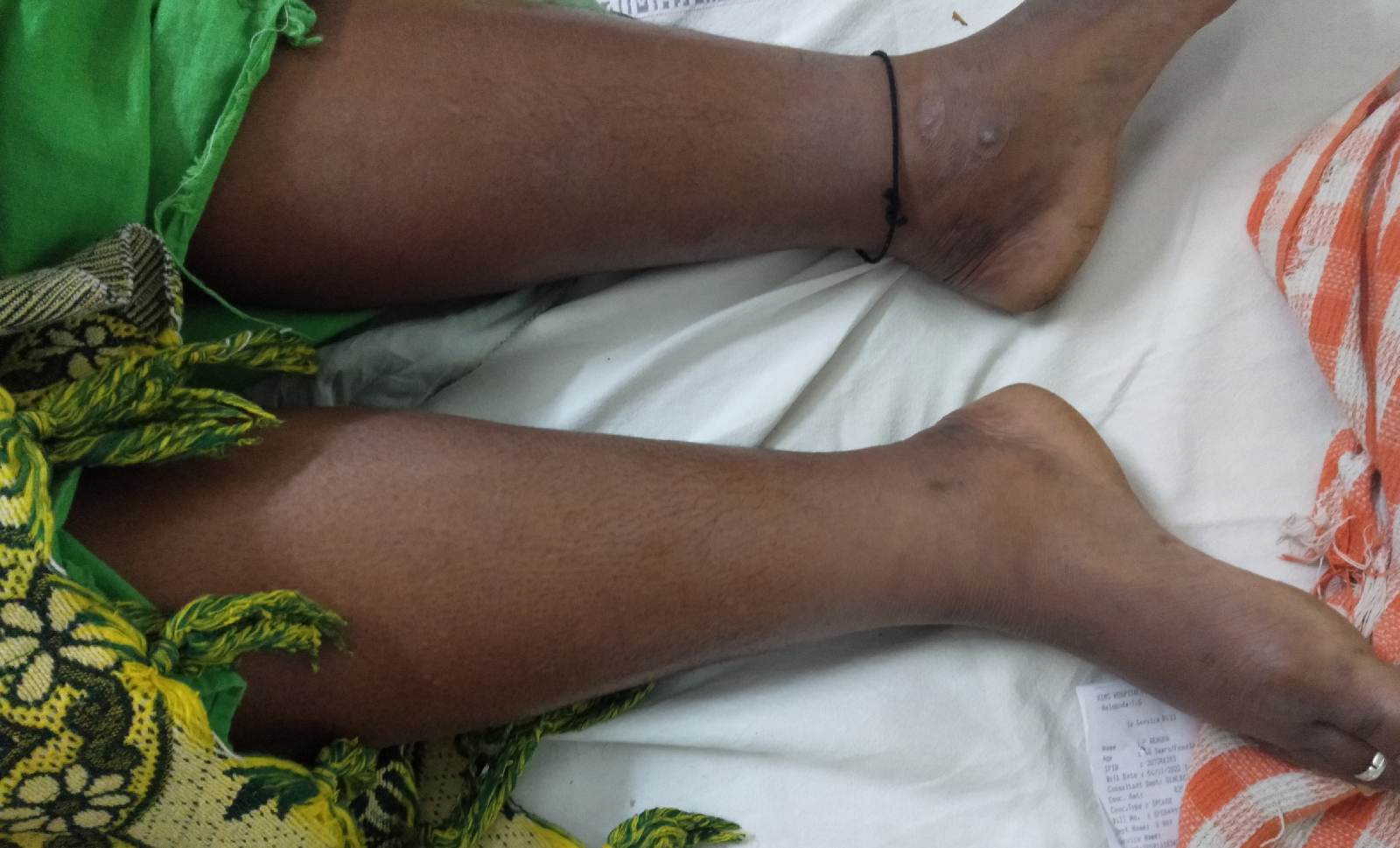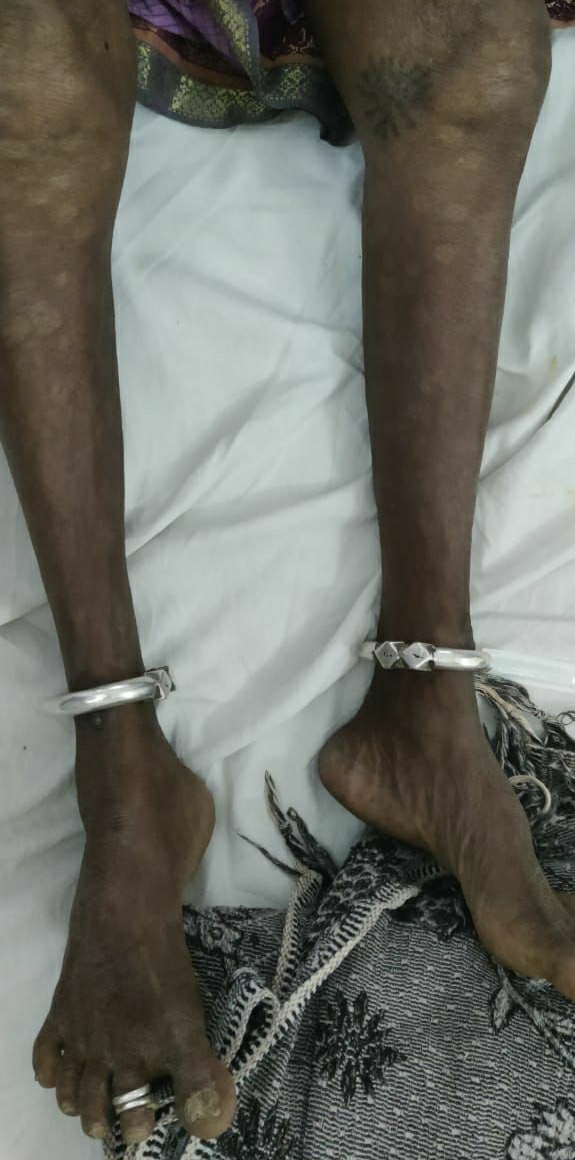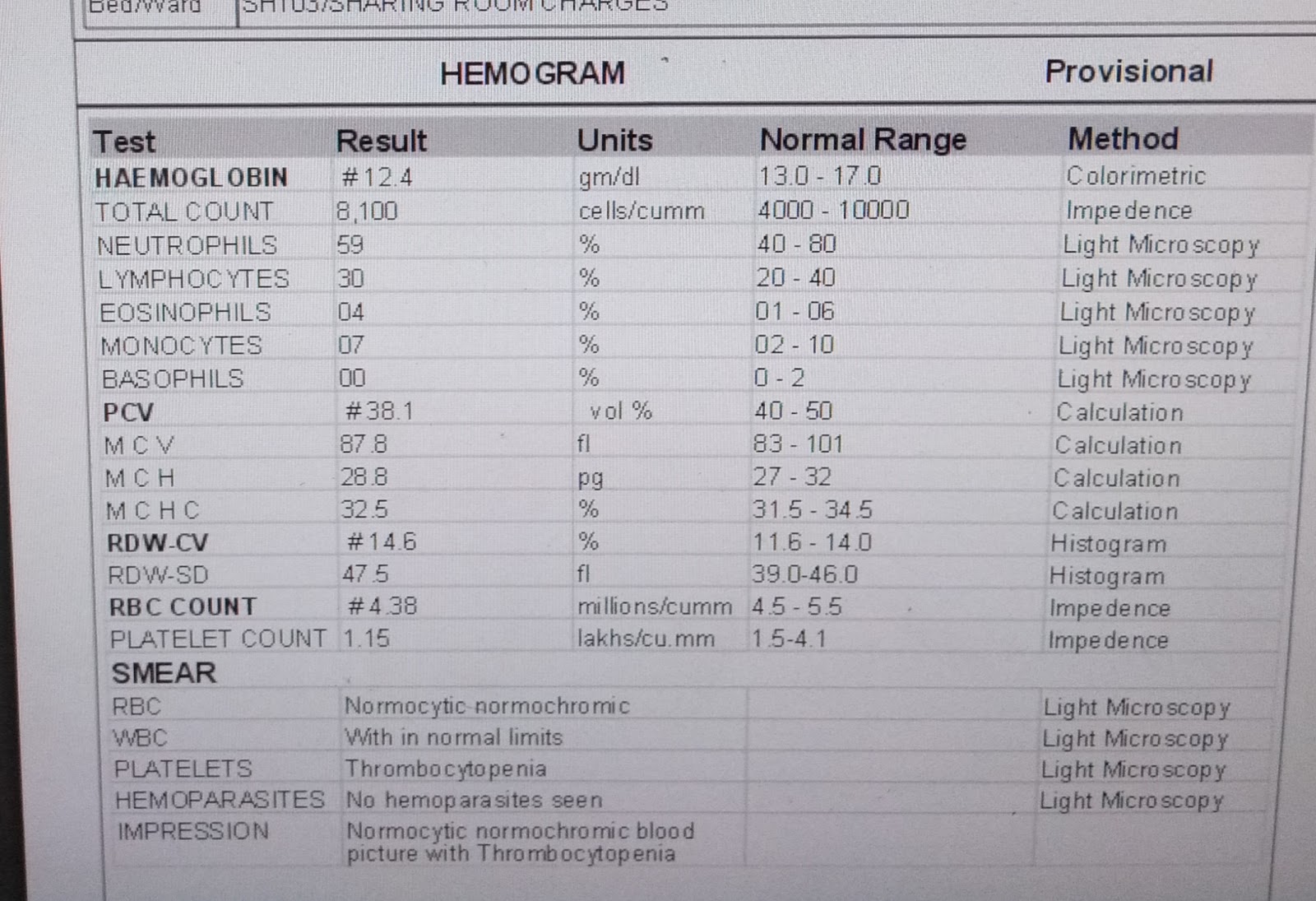Medicine blended assignment
I have been given the following cases to solve in an attmept to understand the topic of 'Patient clinical data analysis' to develop my competency in reading and comprehending clinical data including history, clinical findings, investigations and diagnosis and come up with a treatment plan. This is link of questions asked regarding cases: http://medicinedepartment.blogspot.com/2021/05/online-blended-bimonthly-assignment.html?m=1 Name: Grandhi.N.D.L.S.Srujini
Rollno:41 Below are my answers for the assignment:. 1) Pulmonology. A)https://soumyanadella128eloggm.blogspot.com/2021/05/a-55-year-old-female-with-shortness-of.html
Questions:
1) What is the evolution of the symptomatology in this patient in terms of an event timeline and where is the anatomical localization for the problem and what is the primary etiology of the patient's problem?
Ans)Shortness of breath since 30 days
Pedal odema since 15 days
Facial puffiness since 15 days
Drowsiness since 2 days
Decreased urine output since 2 days
Etiology of patients problem:
She is a farmer by occupation and works in a paddy field during January which is harvest season and develop these symptoms due to dust produced by paddy husks
2) What could be the causes for her current acute exacerbation?
Ans)She has a history of using indoor chulla,she might have developed those symptoms due to repeded exposure of smoke emitted from this
She is also a farmer ,might be due to dust or pollen in the fields
3)Could the ATT have affected her symptoms? If so how?
Ans) Patients who have previously taken anti-tubercular therapy and now developed COPD have high chances of developing multi drug resistant tuberculosis (MDR-TB)
References:
https://www.ncbi.nlm.nih.gov/pmc/articles/PMC4540442/.
4.What could be the causes for her electrolyte imbalance?
Ans)The patient ABG report is showing respiratory acidosis,this might be the cause for her electrolyte imbalance
Reference:
https://www.sjamf.eg.net/article.asp?issn=1110-2381;year=2019;volume=3;issue=2;spage=427;epage=431;aulast=Maklad#:~:text=Hyponatremia%20in%20patients%20with%20COPD,of%20Inappropriate%20Antidiuretic%20Hormone%20Synthesis%2C.
2) Neurology
A)https://143vibhahegde.blogspot.com/2021/05/wernickes-encephalopathy.html
Questions:
1) What is the evolution of the symptomatology in this patient in terms of an event timeline and where is the anatomical localization for the problem and what is the primary etiology of the patient's problem?
Ans) Decreased food intake since 9 days
Short-term memory loss since 9 days
2)What is the reason for giving thiamine in this patient?
Ans) Thiamine reduces confusion and ataxia in wernicke's encephalopathy seen in alcoholics
3) What is the probable reason for kidney injury in this patient?
Ans) Long-term alcohol intake causes kidney damage and shows albuminuria
4)What is the probable cause for the normocytic anemia?
Ans) Alcohol reduces the number of precursor cells in bone marrow and reduce the number of mature red cells ,this causes anemia
5)Could chronic alcoholism have aggravated the foot ulcer formation? If yes, how and why?
Ans) Excessive alcohol intake causes poor nutrition which causes poor would healing and loss of sensations , neuropathy and if foot is injured it may lead to ulceration.
B)https://kausalyavarma.blogspot.com/2021/05/a-52-year-old-male-with-cerebellar.html?m=1
Questions:
1)What is the evolution of the symptomatology in this patient in terms of an event timeline and where is the anatomical localization for the problem and what is the primary etiology of the patient's problem?
Ans) Giddiness-7days
Slurring of speech -2days
Deviation of mouth-2days
2)Did the patients history of denovo HTN contribute to his current condition?
Ans) High blood pressure causes blood clots in arteries which may block blood flow to brain and may cause stroke
3)Did the patients history of denovo HTN contribute to his current condition?
Ans) Alcohol intake causes tachycardia and atrial fibrillation which has high chances of blood clots formation and blocks blood flow and causes stroke which mostly can be ischaemic
C)http://bejugamomnivasguptha.blogspot.com/2021/05/a-45-years-old-female-patient-with.html
Questions:
1) What is the evolution of the symptomatology in this patient in terms of an event timeline and where is the anatomical localization for the problem and what is the primary etiology of the patient's problem?
Ans)*She complains that she could feel her own heartbeat since 5 days and it is more rapid since yesterday night.
*Pain along her left upper limb associated with tingling and numbness-6 days
*Chestpain -since5 days
*Difficulty in breathing-5 days
*Swelling over the legs(bilateral)-8 months
2) What are the reasons for recurrence of hypokalemia in her? Important risk factors for her hypokalemia?
Ans)Risk factors may be female, irregular bowel habits
3) What are the changes seen in ECG in case of hypokalemia and associated symptoms?
Ans)ECG changes in hypokalemia:
-Flatenning and inversion of T- wave
-QT interval prolonged
-Visible U wave
-Mild ST elevation
Symptoms of hypokalemia:
-Alcohol intake
-Chronic kidney disease
-Exessive Sweating
-Exessive laxative use
-Diuretics
D)https://rishikoundinya.blogspot.com/2021/05/55years-old-patient-with-seizures.html
Questions:
1. Is there any relationship between occurrence of seizure to brain stroke. If yes what is the mechanism behind it?
Ans) Stroke causes brain injury which causes scar formation and disrupt electrical activity and causes seizure
2. In the previous episodes of seizures, patient didn't loose his consciousness but in the recent episode he lost his consciousness what might be the reason
Ans) Decreased or increased activity of fronto-parietal association cortex can cause seizure with loss of consciousness
E)https://nikhilasampathkumar.blogspot.com/2021/05/a-48-year-old-male-with-seizures-and.html?m=1
Questions:
1) What could have been the reason for this patient to develop ataxia in the past 1 year?
Ans)The patient is taking high alcohol intake from past 1year which might be the reason for his ataxia
2) What was the reason for his IC bleed? Does Alcoholism contribute to bleeding diatheses ?
Ans)The reason for IC bleed is the patient had history of many falls and minor head injury which can cause bleeding
High alcohol intake contribute to bleeding
F)http://shivanireddymedicalcasediscussion.blogspot.com/2021/05/a-30-yr-old-male-patient-with-weakness.html
Questions:
1.Does the patient's history of road traffic accident have any role in his present condition?
Ans)Yes .The road traffic accident might have caused cerebrovascular changes
2.What are warning signs of CVA?
Ans)-difficulty walking.
-dizziness.
-loss of balance and coordination.
-difficulty speaking or understanding others who are speaking.
-numbness or paralysis in the face, leg, or arm, most likely on just one side of the body.
-blurred or darkened vision.
3.What is the drug rationale in CVA?
Ans)Anti thrombotic agents :Heparin,Exoparin
Anti platelet agents :Cilostazole,Eptifibatide
Thrombolytic agents :Streptokinase,Urokinase
G)https://amishajaiswal03eloggm.blogspot.com/2021/05/a-50-year-old-patient-with-cervical.html
Questions:
1)What is myelopathy hand ?
Ans) loss of power of adduction and extension of the ulnar two or three fingers and an inability to grip and release rapidly with these fingers.
2)What is finger escape ?
Ans)Involuntary abduction of the fifth (little) finger, caused by unopposed action of the extensor digiti minimi.
3)What is Hoffman’s reflex?
Ans)The Hoffman sign is an involuntary flexion movement of the thumb and or index finger when the examiner flicks the fingernail of the middle finger down.
H)https://neerajareddysingur.blogspot.com/2021/05/general-medicine-case-discussion.html?m=1
Questions:
1) What can be the cause of her condition ?
Ans)She has iron deficiency anemia which can be a cause for cortical vein thrombosis
2) What are the risk factors for cortical vein thrombosis?
Ans) Chronic haemolytic anemia
-Beta - thalassemia major
-Iron deficiency anemia
-Dehydration
-Heart disease
- Sickle cell anemia
3)What drug was used in suspicion of
cortical venous sinus thrombosis?
Ans)-Heparin
-Warfarin
Cardiology:
A)https://muskaangoyal.blogspot.com/2021/05/a-78year-old-male-with-shortness-of.html
Questions:
1.What is the difference btw heart failure with preserved ejection fraction and with reduced ejection fraction?
Ans)Heart failure due to preserved ejection fraction is diastolic heart failure due to improper relaxation of ventricle
-Heart failure due to reduced ejection fraction is due to left side heart failure
2.Why haven't we done pericardiocenetis in this pateint?
Ans) Pericardial drainage depends on etiology
3.What are the risk factors for development of heart failure in the patient?
Ans)-Recovery from MI
-Trauma
-viral infection
4.What could be the cause for hypotension in this patient?
Ans)This patient has Pericardial effusion which causes cardiac tamponade ,which reduces heart function and leads to fall in blood pressure
B)https://muskaangoyal.blogspot.com/2021/05/a-73-year-old-male-patient-with-pedal.html
Questions:
1.What are the possible causes for heart failure in this patient?
Ans)Diabetes
Hypertension
2.what is the reason for anaemia in this case?
Ans)The patient is a chronic alcoholic,and long term alcohol intake causes decreased red cells number
3.What is the reason for blebs and non healing ulcer in the legs of this patient?
Ans)The patient had lower limb injury,as he has diabetes which causes poor wound healing and hence non-healing ulcer
4. What sequence of stages of diabetes has been noted in this patient?
Ans) Diabetes mellitus,Diabetic retinopathy, Diabetic neuropathy
C)https://preityarlagadda.blogspot.com/2021/05/biatrial-thrombus-in-52yr-old-male.html
Questions:
1) What is the evolution of the symptomatology in this patient in terms of an event timeline and where is the anatomical localization for the problem and what is the primary etiology of the patient's problem?
Ans) Shortness of breath -2days
Decreased urine output-2 days
2) What is the pathogenesis of renal involvement due to heart failure (cardio renal syndrome)? Which type of cardio renal syndrome is this patient?
Ans)
Inability of the failing heart to generate forward flow, thus resulting in prerenal hypoperfusion. Inadequate renal afferent flow activates the RAAS axis, the sympathetic nervous system, and arginine vasopressin secretion, leading to fluid retention, increased preload, and worsening pump failure
-Type4 cardio renal syndrome
3) What are the risk factors for atherosclerosis in this patient?
Ans) Hypertension
NSAID abuse
4) Why was the patient asked to get those APTT, INR tests for review?
Ans)To check clotting time
D)https://daddalavineeshachowdary.blogspot.com/2021/05/67-year-old-patient-with-acute-coronary.html?m=1
Questions:
1) What is the evolution of the symptomatology in this patient in terms of an event timeline and where is the anatomical localization for the problem and what is the primary etiology of the patient's problem?
Ans) Shortness of breath
2) What are the indications and contraindications for PCI?
Ans) INDICATIONS:
-Acute ST elevation MI
- NSTEMI(Acute coronary syndrome)
- Unstable angina
CONTRAINDICATIONS:
-Intolerance for oral antiplatelets long-term.
-Absence of cardiac surgery backup.
-Hypercoagulable state.
-High-grade chronic kidney disease.
-Chronic total occlusion of SVG.
-An artery with a diameter of <1.5 mm
3)What happens if a PCI is performed in a patient who does not need it? What are the harms of overtreatment and why is research on overtesting and overtreatment important to current healthcare systems?
Ans) Allergic reaction
-Dissection of artery
-Stroke
-Ventricular fibrillation
-Ventricular tachycardia
-Myocardial infarction
E)https://bhavaniv.blogspot.com/2021/05/case-discussion-on-myocardial-infarction.html?m=1
Questions:
1) What is the evolution of the symptomatology in this patient in terms of an event timeline and where is the anatomical localization for the problem and what is the primary etiology of the patient's problem?
Ans)Chest pain-3days
-Giddiness and profuse sweating since morning
2) Did the secondary PTCA do any good to the patient or was it unnecessary?
Ans)Yes, because the patient is alright
F)
https://kattekolasathwik.blogspot.com/2021/05/a-case-of-cardiogenic-shock.html
Questions:
1. How did the patient get relieved from his shortness of breath after i.v fluids administration by rural medical practitioner?
Ans)IV fluids increse heart pumping capacity and reduces blood clots
2. What is the rationale of using torsemide in this patient
Ans)Torsemide reduces left ventricular diastolic pressure and reduces afterload
3. Was the rationale for administration of ceftriaxone? Was it prophylactic or for the treatment of UTI?
Ans) ceftrixone reduces entercoccal re-infection and reduces hospital stay
Treatment of UTI:
-Cefolazane+Tazobactam
-Ceftazidine
-Ciprofloxacin
-Nitrofurantoin
4)Gastroenterology:
A)https://63konakanchihyndavi.blogspot.com/2021/05/case-discussion-on-pancreatitis-with.html
Questions:
1) What is the evolution of the symptomatology in this patient in terms of an event timeline and where is the anatomical localization for the problem and what is the primary etiology of the patient's problem?
Ans)
Pain abdomen & vomiting since 1 week and constipation, burning micturition, fever since 4 days.
2) What is the efficacy of drugs used along with other non pharmacological treatment modalities and how would you approach this patient as a treating physician?
Ans) TREATMENT:
-IV fluid replacement
-Analgesics
-Dietary changes
-Calcium ion antagonists
-Pancreatic secretion inhibitors
B)https://nehae-logs.blogspot.com/2021/05/case-discussion-on-25-year-old-male.html
Questions:
1) What is causing the patient's dyspnea? How is it related to pancreatitis?
Ans) Pancreatitis release inflammatory chemicals into blood stream and cause lung inflammation which leads to dyspnea
2) Name possible reasons why the patient has developed a state of hyperglycemia.
Ans) Pancreatitis damage endocrine pancreas which leads to reduced insulin production and hence causes hyperglycemia
3) What is the reason for his elevated LFTs? Is there a specific marker for Alcoholic Fatty Liver disease?
Ans) Reason for elevated liver enzymes could be presence of gall stones which blocks common bileduct
-Gamma-glutamyl transpeptidase is the biomarker for alcohol fatty liver disease
4) What is the line of treatment in this patient?
Ans)-IV fluids
-Analgesics
-Anti-emetics
-Dietary changes
C)https://chennabhavana.blogspot.com/2021/05/general-medicine-case-discussion-1.html
Questions:
1) what is the most probable diagnosis in this patient?
Ans) Intraperitoneal hematoma
2) What was the cause of her death?
Ans)severe cough and SOB with abnormal vital signs
3) Does her NSAID abuse have something to do with her condition? How?
Ans) NSAID abuse causes gastrointestinal side-effects and leads to perforation
5)Nephrology
A)https://kavyasamudrala.blogspot.com/2021/05/medicine-case-discussion-this-is-online.html
Questions:
1. What could be the reason for his SOB ?
Ans) Absorption of irrigation fluid causes dyspnea
2. Why does he have intermittent episodes of drowsiness ?
Ans)The patient might have developed TURP syndrome where the patient has changes in mental state
3. Why did he complaint of fleshy mass like passage in his urine?
Ans)The might be passage of semen through urine
4) What are the complications of TURP that he may have had?
Ans) Changes in mental state
-Bladder perforation
-Hyponatremia
B)https://drsaranyaroshni.blogspot.com/2021/05/an-eight-year-old-with-frequent.html
Questions:
1.Why is the child excessively hyperactive without much of social etiquettes ?
Ans) Might be because of anxiety
2. Why doesn't the child have the excessive urge of urination at night time ?
Ans) Might be due to psychosocial disturbance
3. How would you want to manage the patient to relieve him of his symptoms?
Ans) Scheduled voiding
-Medications like oxybutynin
-Pelvic floor exercise
6)https://vyshnavikonakalla.blogspot.com/2021/05/a-40-year-old-lady-with-dysphagia-fever.html
Questions:
1.Which clinical history and physical findings are characteristic of tracheo esophageal fistula?
Ans)The patient has history of tuberculosis which might cause tracheo oesophageal fistula
2) What are the chances of this patient developing immune reconstitution inflammatory syndrome? Can we prevent it?
Ans)This patient have developed TB after taking ART and can be prevented by giving Anti -TB drugs
7)Hepatology
A)https://kavyasamudrala.blogspot.com/2021/05/liver-abscess.html
Questions:
1. Do you think drinking locally made alcohol caused liver abscess in this patient due to predisposing factors
present in it ?
Ans)Toddy drinking has high chances of liver abscess
2. What is the etiopathogenesis of liver abscess in a chronic alcoholic patient ? ( since 30 years - 1 bottle per day)
Ans) Alcohol is not an etiologic factor ,but predisposing factor to amoebic and pyogenic liver abscess
3. Is liver abscess more common in right lobe ?
Ans)Liver abscess is common in right lobe because it has blood supply from both mesenteric and portal arteries
4.What are the indications for ultrasound guided aspiration of liver abscess ?
Ans) Amoebic liver abscess
B)https://63konakanchihyndavi.blogspot.com/2021/05/case-discussion-on-liver-abcess.html
Questions:
1) Cause of liver abcess in this patient ?
Ans) Amoebic liver abscess
2) How do you approach this patient ?
Ans) Antibiotics
-Analgesics
-Aspiration of abscess
3) Why do we treat here ; both amoebic and pyogenic liver abcess?
Ans)To prevent complications
4) Is there a way to confirmthe definitive diagnosis in this patient?
Ans) Abdominal ultrasound
8) Infectious disease (Otolaryngology)
http://manikaraovinay.blogspot.com/2021/05/50male-came-in-altered-sensorium.html
Questions:
1) What is the evolution of the symptomatology in this patient in terms of an event timeline and where is the anatomical localization for the problem and what is the primary etiology of the patient's problem?
Ans)
Fever since 10 days
Facial puffiness and periorbital edema since 4 days
Weakness of right upper limb and lower limb since 4 days
Altered sensorium since 2 days
2) What are the postulated reasons for a sudden apparent rise in the incidence of mucormycosis in India at this point of time?
Ans)Beasuse of increased usage of steroids in COVID patients
9)COVID cases
1)https://nikhilasampathkumar.blogspot.com/2021/05/covid-pneumonia-in-pre-existing-case-of.html
Questions:
1) How does the pre-existing ILD determine the prognosis of this patient?
Ans) Pre-existing ILD increased the duration of prognosis and increase hospital stay
2) Given the history of autoimmune disease in the patient, how does the administration of steroids for COVID affect her RA and hypothyroidism?
Ans)The usage of steroids should be reduced as they are immunosuppresed to prevent infection
3)Why was she prescribed clexane (enoxaparin)?
Ans)This is given as prophylaxis to prevent thromboembolic disorders
2)https://nehapradeep99.blogspot.com/2021/05/a-50-year-old-female-with-viral.html
Questions:
1) Since patient didn't show any previous characteristic diabetes signs, did the Covid-19 infection aggravate any underlying condition and cause the indolent diabetes to express itself? If so what could be the biochemical pathways that make it plausible?
Ans)Our body adapts to hyperglycemia so that the virus thrives in this environment and reduces inflammation
2) Did the patient's diabetic condition influence the progression of her pneumonia?
Ans) Diabetes reduces the immunity of person and can lead to its progression
3) What is the role of D Dimer in the monitoring of covid? Does it change management or would be considered overtesting?
Ans) D-Dimer levels helps to know the coagulative status of the patient
-This helps in treating the thrombotic disorders
3)https://143vibhahegde.blogspot.com/2021/05/covid-in-26-yo-female.html
Questions:
1. Why was this patient given noradrenaline?
Ans)To maintain blood pressure
2. What is the reason behind testing for LDH levels in this patient?
Ans)To check for multiorgan failure,LDH levels is high inside cells ,if it is seen in blood indication of cell injury
3. What is the reason for switching from BiPAP to mechanical ventilation with intubation in this patient? What advantages did it provide?
Ans) Normally bipap should be given upto 48 hrs ,if the patient does not improve should be shifted to intubation
Advantages:
-Hypercapnia is improved
-prevents pressure necrosis of nasal skin
4)https://gsuhithagnaneswar.blogspot.com/2021/05/29-year-old-male-patient-with-viral.html?m=1
Questions:
1). Is the elevated esr due to covid related inflammation
Ans)The etiology for elevated esr in COVID is not known
2. What was the reason for this patient's admission with mild covid? What are the challenges in home isolation and harms of hospitalization?
Ans) Shortness of breath which was 3rd grade
-If the patient experience sudden change in oxygen ,it is difficult at home
-In hospital,the patient might psychological deteriorated



